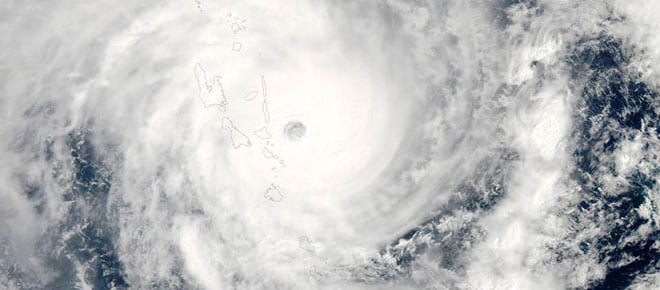Oxfam is ready to respond to Cyclone Pam after the storm was upgraded to a severe Category 5 tropical cyclone overnight, triggering evacuations to emergency shelters across Vanuatu’s southern provinces. Forecasts predict the storm will pass close to Vanuatu’s capital Port Vila.

Oxfam is ready to respond to Cyclone Pam after the storm was upgraded to a severe Category 5 tropical cyclone overnight, triggering evacuations to emergency shelters across Vanuatu’s southern provinces. Forecasts predict the storm will pass close to Vanuatu’s capital Port Vila, the city recently named as the most exposed to natural disasters in the world.
Oxfam New Zealand’s Executive Director Rachael Le Mesurier said if the cyclone followed its current predicted path, the results could be devastating for Vanuatu.
“Even if Tropical Cyclone Pam does not strike the city directly there is potential for major damage,” Ms Le Mesurier said.
“Under normal circumstances Port Vila is prone to flash flooding, which makes roads impassable, so flooding from this cyclone is expected to be much worse.
“People have started evacuating to emergency centres established in schools and churches where they are available. Communities in low lying informal settlements are most vulnerable and these people are urgently being asked to move to higher ground.”
“Oxfam and other humanitarian agencies are ready to respond with emergency stocks available to be moved into stricken areas if required,” Ms Le Mesurier said.
Vanuatu Country Director Colin Collett van Rooyen said the areas of greatest concern were SHEFA province in the country’s south, where the capital is located, and TAFEA province in the far south.
“Tropical Cyclone Pam is now forecast to pass within 145km of by Port Vila about 8pm on Friday night, bringing with it potential winds speeds of up to 280km/h,” Mr Collett van Rooyen said.
Warnings have been issued for high seas, coastal flooding and destructive winds already seen in the north of the country. There are major concerns for the health system, with the hospital in Port Vila prone to flash flooding in much less severe conditions.
“Port Vila was recently named in the Natural Hazards Risk Atlas and is known as the city most exposed to natural disasters in the world because it faces a combination of risks including earthquakes, tsunamis, flooding and tropical cyclones such as Cyclone Pam,” Mr Collett van Rooyen said.
“The SHEFA Province has a population of around 80,000 people and TAFEA a further 32,000. If the current path predictions are correct the impact on these people could severe.”
Oxfam is leading the coordination of the Vanuatu Humanitarian Team, a network of non-government humanitarian agencies, in preparing for the storm, and will also support any response effort, working alongside the Vanuatu Government. Residents on remote islands have been alerted to the storm by text messages sent by Vanuatu’s National Disaster Management Office.
Reports from Oxfam in Vanuatu
OxfamInVanuatu:#CyclonePam Red alert in place now for SHEFA province Vanuatu. People rushing about to get to homes or shelters.
— colin (@Colincvr) March 13, 2015
OxfamInVanuatu: #CyclonePam Pango village NTM evac shelter supervisor pastor David Stephen ‘we are ready and will get busy here soon’.
— colin (@Colincvr) March 12, 2015
OxfamInVanuatu: #CyclonePam at aprox 02:00/13Mar – Cat 5 and moving at about 16km/h with winds of abt 215km/h at centre. A rough day ahead.
— colin (@Colincvr) March 12, 2015
OxfamInVanuatu:more abt Vanuatu provinces (prev tweet).Not all islands shown/named on map.Picsource: vanuatutravels pic.twitter.com/axyqbg0sZ6
— colin (@Colincvr) March 12, 2015
OxfamInVanuatu: #CyclonePam– did you known that Vanuatu’s 6 province names are made up of initial letters of their island names?See map next
— colin (@Colincvr) March 12, 2015
OxfamInVanuatu: #CyclonePam “We have never seen what a Cat 5 cyclone can do. It is new for us” Local talk in Vila today as the town prepares
— colin (@Colincvr) March 12, 2015
Oxfam in Vanuatu: international non govt agencies working together to plan and respond to #cyclonepam and engaging with govt too on this.
— colin (@Colincvr) March 11, 2015



